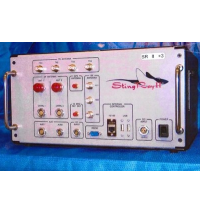ACLU Sues 2 Cop Shops over Stingray Surveillance Secrecy
 Harris Corporation's StingRay (photo: U.S. Patent and Trademark Office)
Harris Corporation's StingRay (photo: U.S. Patent and Trademark Office)
The federal government has funded secretive purchases by local law enforcement agencies nationwide of Stingray surveillance equipment that can track people’s movements by mimicking cellphone towers.
Police agencies have turned away inquiries as basic as, “Do you have a Stingray,” and fended off court challenges to using the devices. The case for banning the technology is made more difficult by a lack of information about how they are used. So the American Civil Liberties Union (ACLU) sued the Anaheim Police Department (pdf) and the Sacramento County Sheriff's Department (pdf) in separate Superior Court cases to remove the cloak of secrecy.
The lawsuits, which are similar to one filed by the First Amendment Coalition in December against the San Diego Police Department, seek documents that are generally considered public records, including contracts or other agreements with the manufacturer. Harris Corporation makes the market dominant StingRay, whose name has been adopted as a generic for similar products.
Among Harris’ contract requirements is a non-disclosure clause, which law enforcement has used in arguing the primacy of so-called “trade secrets” over the California Public Records Act (CPRA).
The ACLU asked the Sacramento sheriff for a variety of documents on its use of Stingray last May. The department acknowledged possession of the documents but refused to release them at first, before finally providing five heavily-redacted documents. The ACLU said the department cited the Homeland Security Act and the Arms Export Control Act among its justifications for clamming up.
The ACLU was no more successful with the Anaheim police in July. The cops acknowledged having the documents but, the ACLU said, they argued that the request was too vague. They also cited trade secrets.
Stingrays have been around for years and have mostly been used domestically by the FBI. But the accelerated militarization of local police since 9/11 has contributed to the widespread use of the technology by local cops, raising serious questions about privacy and abuse of civil liberties. An estimated 40-50 law enforcement agencies use them.
Stingrays work by acting like cell towers. All cellphone calls in their area are captured by the device and then the signal sought by the authorities is isolated via its unique IMSI number. It works as long as the phone is on, but the phone doesn’t have to be in use.
The device can be used to effectively track the whereabouts of a person without planting a bug on them and, so far, no one has told the police they have to use a warrant. The federal government has argued for years that warrants aren’t needed since Stingrays don’t reveal the content of messages, and cellphone users have no expectation of privacy. But some do request them.
The Sacramento lawsuit claims: “When they do seek a warrant or court order, law enforcement may not adequately explain the nature of IMSI catchers to the court: multiple news reports have uncovered evidence of judges unwittingly signing hundreds of warrants authorizing the use of IMSI catchers.”
A lot is now known about the technology, but little is known about their deployment. The lawsuits say the technology can be configured to capture more than just the location of a subject: “IMSI catchers can also capture the content of communications, such as voice calls and text messages.”
The devices are broadly used by law enforcement without any oversight by the public, government agencies or courts. Although the authorities pitch the devices as enhanced tools for important local police cases, like homicides, kidnappings, narcotics and rape, they invoke national security arguments for keeping their activities clandestine.
Randy Dotinga optimistically wrote in the Voice of San Diego: “The wall of silence is crumbling.” But, in the meantime, if you want to avoid being part of a Stingray sweep at the next Occupy protest rally, he suggests picking up the SnoopSnitch Android app to find out who’s got you in their sights.
It won’t stop the surveillance, but you can turn off your cellphone to do that. Maybe. Some folks recommend removing your battery, too.
–Ken Broder
To Learn More:
Anaheim Police, Sacramento Sheriff Sued over Surveillance Device (by Richard Winton, Los Angeles Times)
Five Things to Know About Police Cell-Phone Spying (by Randy Dotinga, Voice of San Diego)
Police Shouldn't Engage in Indiscriminate Secret Cell Phone Surveillance (American Civil Liberties Union)
Lawsuit Wants San Diego Police to Go Public about Stingray Surveillance (by Ken Broder, AllGov California)
American Civil Liberties Union of Northern California v. Sacramento County Sheriff’s Department (Sacramento County Superior Court) (pdf)
American Civil Liberties Union of Northern California v. Anaheim Police Department (Orange County Superior Court) (pdf)
- Top Stories
- Controversies
- Where is the Money Going?
- California and the Nation
- Appointments and Resignations
- Unusual News
- Latest News
- California Forbids U.S. Immigration Agents from Pretending to be Police
- California Lawmakers Urged to Strip “Self-Dealing” Tax Board of Its Duties
- Big Oil’s Grip on California
- Santa Cruz Police See Homeland Security Betrayal in Use of Gang Roundup as Cover for Immigration Raid
- Oil Companies Face Deadline to Stop Polluting California Groundwater





